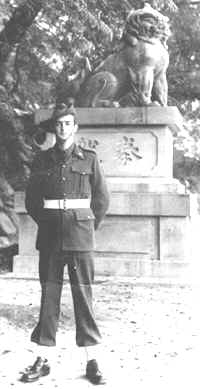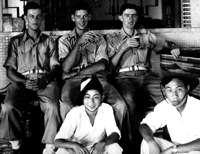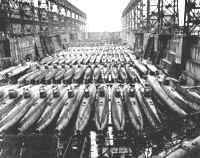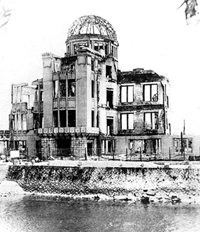 |
|
Ray
Cooper in Hiroshima in 1996.
|
| |
 |
|
Ray
Cooper in Hiroshima, uniformed in the same spot as above in
1946.
|
| |
 |
|
Ray
Cooper (right) and mates from A Fd Bty on R&R.
Photos provided by Ray Cooper and AWM
|
| |
 |
|
Unfinished
midget submarines at Kure.
Photos provided by Ray Cooper and AWM
|
| |
 |
|
The
dome at the epicentre of the blast. Unaware of the hazard,
Ray Cooper climbed all over the building.
|
Radiation
wasn’t a consideration for the occupation forces in Hiroshima – no
one knew about it – as Ray Cooper explained to Cpl Cameron Jamieson
It was bitterly cold for the Australian artillerymen lining the deck
of the US Army Transport Service Ship Pachaug Victory as it glided
across the Inland Sea towards the naval docks at Kure.
As the troopship made its way past the snow-capped jagged mountains of
the surrounding islands they were reminded of the tropical heat and
humidity of the southwest Pacific island they had sailed from only a
week before.
Then, as they approached the docks, the diggers stared in awe at the
remains of the once-mighty Imperial Japanese Navy.
Among the craft that littered the harbour was the hulk of the
battleship Haruna lying quietly in the shallows, its deck just above
the water.
In contrast, there was seaworthy aircraft carrier Hosho, which had
avoided destruction and was being used to repatriate Japanese soldiers
from the expanse of their collapsed empire.
Kure had once been a closed city, with only the Japanese military
allowed to enter its sombre surrounds.
Now it was the landing point for the tens of thousands of British
Commonwealth Occupation Force (BCOF) soldiers who would occupy the
Hiroshima Prefecture for the next six years.
Hatred and pity
Gnr Joseph Raymond Cooper had missed out on WW2 service due to his
youth.
The war had ended just before he could be deployed to the southwest
Pacific, but he leapt at the chance to serve with A Field Battery, a
part of the Australian occupying force in Japan.
During their preparation on Morotai Island, the members of the battery
had discussed how they would deal with their hatred for the
surrendered enemy.
“We’d already seen some of our released prisoners of war who had
been badly treated by the Japanese, so we were a bit uptight about
that,” recalls Cooper.
“On landing in Kure Harbour we had to march nearly a mile around
through the wharfs to the railway station to head off to Kaitaichi.
“The Japanese populace were lined up along the route, and we saw
these poor, starving people, the women dressed in traditional kimonos
with babies on their backs, and the Japanese soldiers, still in their
ragged uniforms, all looking pretty sullen.
“Our first impression was ‘the poor buggers’.
“It was an anti-climax to our built-up thoughts about the Japanese,
those first hours in Japan.”
Hiroshima
For many Australian soldiers, their new home in Japan would be the
primitive and dilapidated old warehouses in Kaitaichi, about nine
kilometres from the city of Hiroshima.
The devastation of the world’s first atomic target was well known,
and naturally the Australians were keen to get away and visit the
city.
“I remember the first time I got off the train,” says Cooper.
“It wasn’t difficult to find the centre of the blast because
everything was bent away – telegraph poles and steel stanchions.
“There were no real memorials then, it was just an area.”
He took the opportunity to climb through the ruins of the Industrial
Promotion Hall, the iconic building near the epicentre of the blast,
now declared a UNESCO World Heritage Site and called the Atomic Bomb
Dome.
“I’ve climbed all through that building. We had no fear because we knew nothing about radiation then.
“There were some people in white overalls with these little boxes
that went “tic-tic” – we’d never heard of Geiger counters
either.
“I see it in my minds eye, the city of Hiroshima was a great sea of
broken crockery, tiles, bicycle frames and safes – every house
seemed to have a safe.
“Most of the houses had been made of wood and they had burnt down. So there were just acres and acres of broken crockery and tiles.”
Cooper and his fellow soldiers were in awe at what they saw.
“We were absolutely amazed at the damage one bomb could do. The whole place was just wiped clean, only the substantial
buildings with concrete, stone or steel frames had any resemblance of
shape.”
What really amazed the soldiers though, was how the Japanese did not
seem to have any animosity about being bombed.
“They said ‘well, a bomb is a bomb, whether it is high-explosive
or happens to be an atomic bomb’.
“They seemed to be philosophical about it.”
Ready for action
The primary objectives of BCOF were to ensure that there was no
military or civil uprising in Japan after the surrender, and to
dismantle the means by which Japan had waged war.
In July 1946 BCOF troops supervised the disposal of 100,000 tons of
explosives and 5000 tons of poison gas in the Hiroshima Prefecture
alone.
For the men of A Field Battery, their job was to ensure that they were
ready for action at any time.
“At first we were concerned about civil insurrection, but the
Emperor said stop and they stopped – the Japanese really did obey
the Emperor,” remembers Cooper.
“After the first six months they settled into a routine and
everybody was happy.
“We gave them work, and got the whole place booming.
“I think they were appreciative of the Australians.”
Seeing Tojo
During his BCOF service Cooper was sent to Tokyo for a stint of guard
duty.
While he was there he had the opportunity to watch the International
Military Tribunal prosecute key Japanese war criminals.
Among the personalities in the courtroom that morning was the infamous
Hideki Tojo, the former Japanese Prime Minister and Minister for War.
“Tojo was someone we would paint on our targets at the rifle
range,” Cooper says.
“He was a little tubby fellow, and looked forlorn sitting there.
“He was the symbol of the Japanese war effort, yet he looked like a
harmless fellow.
“I wondered why he was such an important person – he lacked any
presence.
“But I was privileged to see him at the trial, it was an important
part of history.”
Return to Hiroshima
In 1996 Cooper had the opportunity to return to Hiroshima for the 50th
anniversary of BCOF’s arrival in Japan.
“It’s a beautiful city, they have rebuilt it really nicely,”
says Cooper.
“Even the old Hiroshima Castle, which had been completely destroyed,
has been rebuilt and it looks as though it really is 400 years old.
“The old main street still looks the same, they have the same
granite bits down the tram lines, and some of the old trams are
running.
“But I was very disappointed to see that the Peace Museum has no
mention of the occupation.
“They’ve virtually obliterated all our footprints.
“Australia occupied Hiroshima for six years, and it’s very
difficult to find signs that we were even there.
“I think we treated them well and we did a lot for them.
“It was a little disappointing to find hardly any recognition that
we were ever there.”
Reflections
For Cooper, his 18 months of service with the occupying powers in
Japan was a significant part of his life.
“I think we were participating in a very important part of history. I didn’t realise it at the time, but when you look back now you
see that it worked so well. Japan went from a feudal militaristic country to a real democracy.
“I think we must have done something right.”